#the cult of st michael
Explore tagged Tumblr posts
Text
So most practioners who invokes Michael likely knows about the number of cults formed around him,
and at first brush it would seem the cults explode during apocalyptic times (see an example of St. Michael's Cults starting up in Istria) because they're calling for his protection and grace (which they are),
but what these specific examples I'm going to post have in common with the broader representation of Michael is 'oneness'. Combined with the fact that he is the primordial representation for assertive, Martian energy, I theorize his cults often worship men, masculinity, or expressions OF masculinity (like having a strong sex drive).
It's a niche thought, but here's a couple of examples I was able to find:
Example 1) Valentine Michael Smith, Stranger in a Strange Land

A cult famous sci-fi novel by Robert Heinlein, made in 1961. The main character, Michael, is the only surviving Martian that made his way to Earth and was held captive for study. Upon being broken out and discovering Free Will, he starts his own religion and creates a polyamorous commune in order to empahsize that 'Thou art God . . . and I am God. All are God, for God is in everything and every thought.'
Example 2) Mike Myers, Austin Powers

We can all admit this is an outdated parody from the late 90s and early aughts, but all absurdity aside, the odd consistency of Mike being a famous playboy with the Symbol of Mars on his necklace is a subtle nod to the above theme.
#archangel michael#angelology#st michael#heresyposting#the cult of st michael#the concept of 'oneness' and all being like God through him is either a more niche thought /#or it got buried by the more mainstream/popular thought of him being the Divine Host and focused on protection /#either way the cults started for him were not /#remember: Paul's early preachings in 1st century AD spread angelic cults throughout Asia Minor as a result /#this man had/has worshippers /
3 notes
·
View notes
Text

Party Monster, 2003
#gifer#gif#troll#party monster#macaulay culkin#seth green#2003#film#movie#2000s#michael alig#james clark#james st james#club kids#it's all about self-expression if you feel like a troll then you should look like a troll#cult film#cult movies
15 notes
·
View notes
Text
Batman’s love interests 💕 OooohooHOO!
Okay, so in Gotham Files, it’s going to be canon that Bruce dated all of these women at some point in time, because he is a billionaire playboy philanthropist.
First off, there’s Zatanna, and they dated briefly back in high school. It didn’t work out because Bruce was still very much not in a good place, still grappling with the loss of his parents, being the “Prince of Gotham,” etc, etc. So they grew apart and went their separate ways. (This is Z when she was 18-20ish)

Vicki was his college flame. (Side note, this pic is Vicki when she’s an adult, in [current year] of the tv show.) Anyway, they had their fun, but Bruce was really just trying medicate his ✨ trauma ✨ and his ✨ feelings ✨ with good times, and it quickly became apparent that they weren’t a real solid couple in the ways that matter. So, by the time they graduated, they had already broken up. They both knew what paths in life they were taking, and they were going in two different directions.

Then there’s the fan-favourite, Talia Al Ghul. After college, Bruce went on his world travels, did a bunch of soul searching, learned a lot of skills, had a lot of teachers, vented a lot of his anger, and wound up learning under Ra’s Al Ghul in the League of Shadows, and wouldn’t you know it, he has a daughter and they kinda dig each other. It was probably the most passionate relationship Bruce had ever had up until that point, and he might have pursued her all the way… if it weren’t for the whole death cult thing… So, even though they had great chemistry, their moral codes were simply not aligned at all, and so it was destined to fail.
Theme: Clarity, covered by Sam Tsui

Then, when Bruce got back to Gotham, he wound up running into an old childhood friend of his, Silver St. Cloud. She’s a member of the Gotham upper class, they knew each other as kids, and I’m thinking it might be cute if she was always crushing on him back then, like that one girl who would just openly say things like, “Marry me!” and it’s super cute, but the feelings are NOT reciprocated XD Anyway, this relationship will only last a short while, and I haven’t decided if I want to play it straight, or use it for comedic purposes, or do both, but it’ll be fun either way.
Theme: Crowded Room by Meghan Trainor

Finally, there’s Selina, who needs little introduction. She is the end game. She is my OTP. The bus stops here. I give you, Mrs. Wayne.
Theme: Never Not Love You by Michael Buble

#art#fan art#dc#dc comics#batman#selina kyle#catwoman#talia al ghul#silver st cloud#vicki vale#zatanna
414 notes
·
View notes
Text
“You hate Dazai-san right.”
“Don’t act like a detective! That bastard is just.. just very, y’know.. It’s not hate.”
Looks like some complicated feelings.
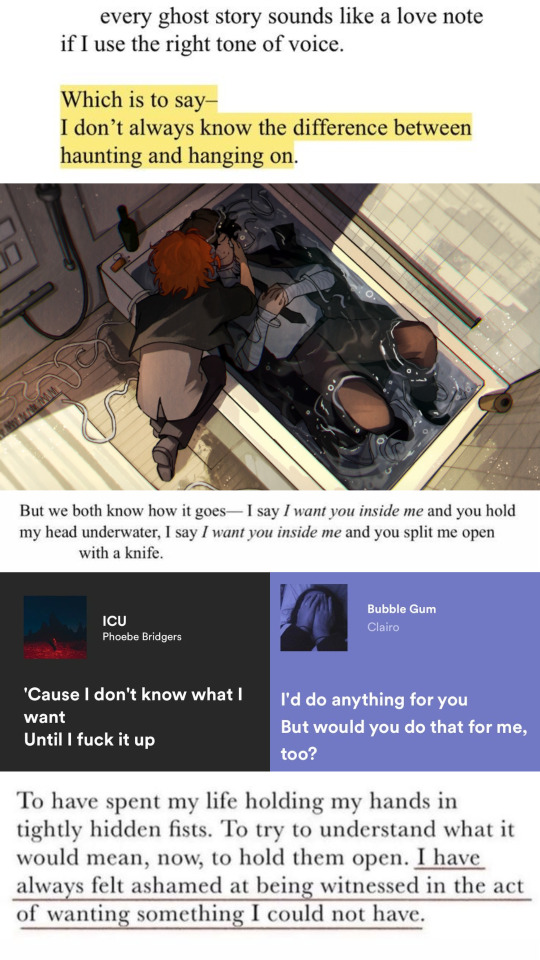


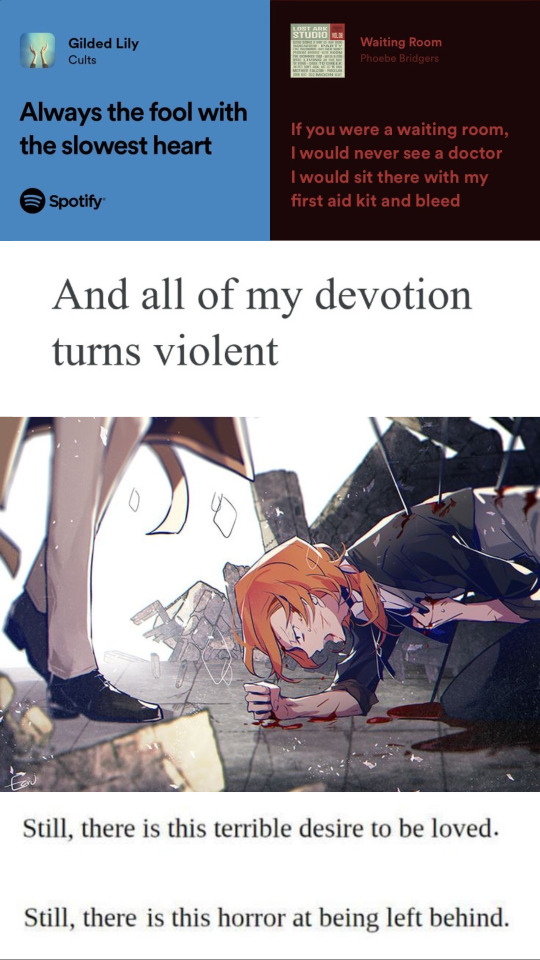
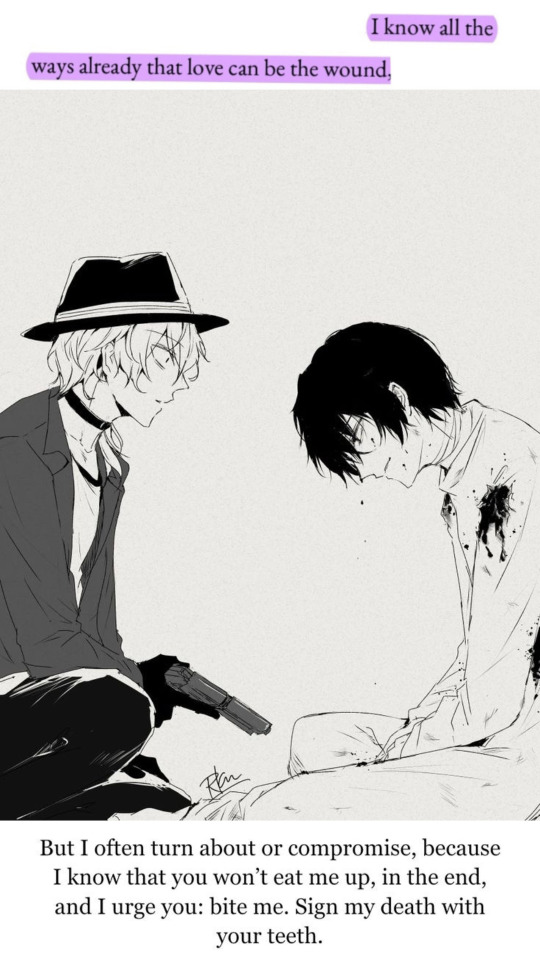

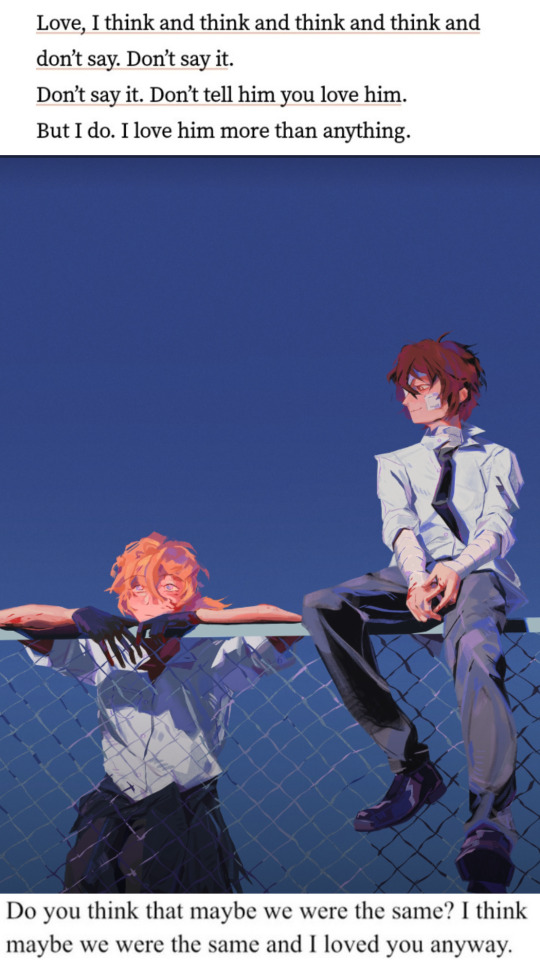
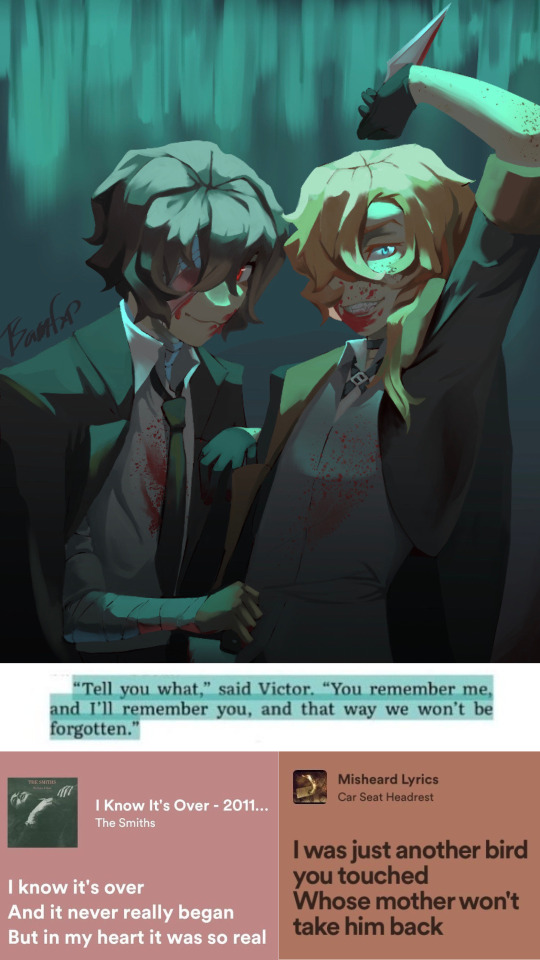

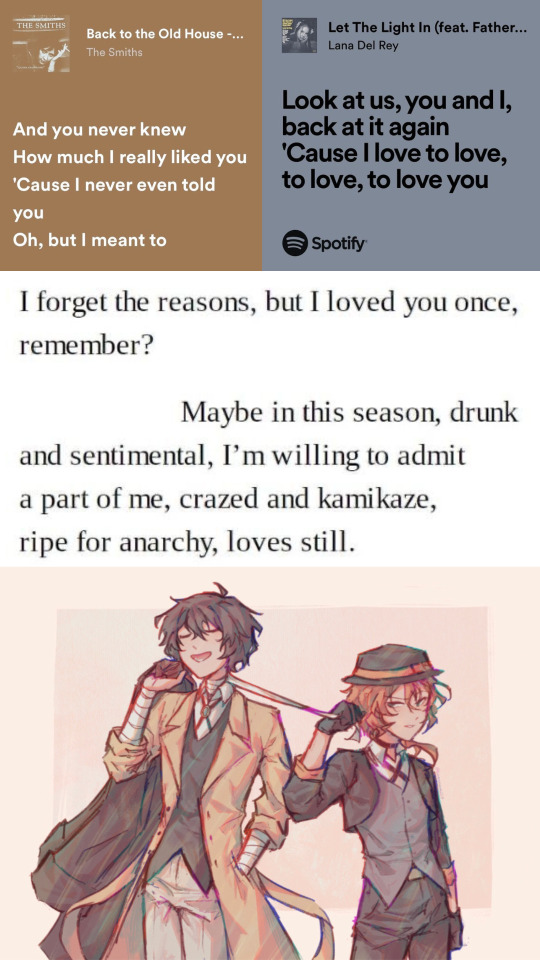
soukoku webweaves: 1 , 2 , 3 , 4 , 5 , 6 , 7
creds:
cold spot - Trista Mateer// art by @taxolotl// wishbone - Richard Siken// ICU - Phoebe Bridgers// bubble gum - Clairo// so we must meet apart - Gabrielle Bates & Jennifer S. Cheng// essays in love - Alain de Botton// youth - daughter// dear Arkansas daughter - lady lamb// fleabag - Phoebe Waller-Bridge// sweetbitter - Stephanie Danler// art by @pleucas// the first bad man - Miranda July// in the aeroplane over the sea - neutral milk hotel// the beach - the neighbourhood// gilded lily - cults// waiting room - Phoebe Bridgers// boyish - Japanese breakfast// art from @/HiChuya on twitter// the hours - Michael Cunningham// yves olade// art from @/rokkyun1 on Twitter// stigmata: escaping texts// Hélène Cixous// wolf OR7 - Natalie Diaz// art by @thornedarrow// poem for a birthday - Sylvia Plath// unknown// art by @pleucas// lev st valentine// art by @bamfxp// vicious - V.E Schwab// I know it’s over - The Smiths// misheard lyrics - car seat headrest// be nice to me - the front bottoms// paper bag - Fiona Apple// trista mateer// art from @/1hys12 on Twitter// back to the old house - the smiths// let the light in - Lana del Rey// one last poem for Richard - Sandra Cisneros// art by @bananana2217
tagging moots and users who liked the other parts :)
@dinosaur-mayonnaise @philzokman @amagami-hime @homuncvlus @vinylbiohazard @bunglegaydogs @zamxii @ghostsinacoat @slug-behaviour @beastchuus @vivid-vices @atsuwushi @gorotic @pendragonstar @ricelover888 @oatmilkbasic @thou-shalt-cha-cha-real-smooth @the-gayest-sky-kid @lotus-reblogs @whiteapplesandblackblood @dazaiyurii @sommmee @shroombunnieses @sempieternal @sigskk @everyversionofmedeadandburied @thesunshinebard @hornyforthevirginmary @chibiko @galaxitic @evermorehypewoman
#bsd#soukoku#skk#bungou stray dogs#dazai osamu#nakahara chuuya#izzie posts#dont flop ill cry /srs#dazai chuuya age fifteen#bsd fifteen#bungo stray dogs#bsd stormbringer#stormbringer#bsd soukoku#bsd skk#bsd angst#skk angst#teen skk#teen soukoku#skk webweaving#skk fluff#soukoku fluff#web weaving#soukoku angst
720 notes
·
View notes
Text
There's been more than one antipope in recent memory...it didn't just start in a Chicago school.
By the way, this might be the first time we've had both a Chicago Pope and Chicago Antipope. So there's that. I wrote all of this before the election of Leo XIV, but it still holds as true as I could make it. Most of my sources, as you'll note, are just Wikipedia pieces or direct links to sites.


Once upon a time (until his death in 2022), there was Pope Michael I of...Kansas.
A more serious look at his...Papacy (three followers plus his parents and maybe some Ultra Trad Sedevacantists on Tradcath Twitter).
And there was Gregory XVII

And Clement XV, his predecessor...in a small Sedevacantist cult known as the Apostles of Infinite Love in Quebec.
Greg 17 definitely carried on one tradition some popes indulged or covered up in...yeah, you guessed it...he was a rapist.
Wait, there's another Gregory XVII! But this one was Spanish. And also a rapist--running a cult church in Spain makes you a shoe-in for that sorta thing...c'mon...

You're telling me this guy (I'm pretty sure he was alive in the middle photo)... wasn't a sex pest of some sort (he definitely was).
He was blind, so...don't let lack of sight stop you from having a vision.

Unless that vision is to become Pope Greg so that you can abuse your self-appointed position of power to rape people and steal hand over fist from your cultists. Then maybe dream a little less antipapal and definitely less rapey. At least less rapey. Honestly if you want to become Antipope Gregory XXX Xander Cage, that's...fine. But you better drive the AntiPopemobile off a bridge and jump out with a cool parachute. Doing that while blind would be really impressive, like, I'd join your church because surviving that shit shows divine favor.
There was also a movie made making fun of him while he was Pope. Since it was made in Spain in 1986, I'm sure some of the humor might not be the most PC, but goddamn Spain, you just went for the throat like it was 1936 again. Good for you. Way to learn from years of Francoism, inquisitions, and Every Other Damn Thing the Church has put you through. I mean, you're not taking swings at the Big Guy in Rome, but a lot of your population is still Catholic and like Super Vocal about stuff so, hit where you can.
Following his death in 2005, the day after, like his liver wasn't even cold yet, Antipope Peter II (Manuel Alonso Corral), his successor, canonised him as a Catholic saint in the Palmarian Catholic Church as "Pope St. Gregory XVII the Very Great". So take that just Pope Saint Gregory the Great and all the other Saints Greg out there. They got you beat.


At least the Palmarians have a fancy (if a little tacky, but they might be compensating for their complete lack of legitimacy) antipapal cathedral-basilica. Peter II's successor , Gregory XVIII, was shunned by the Palmarians when he...stepped down as Pope, recanted his entire cult, and rejoined Rome as a layman, probably the only sensible guy in the bunch, just looking around and going, "Nah, we're not like serious with this, are we, guys? Like I saw the movie about the last Greg and it was pretty funny." Don't worry, you can still go there and high five Pope Peter III.
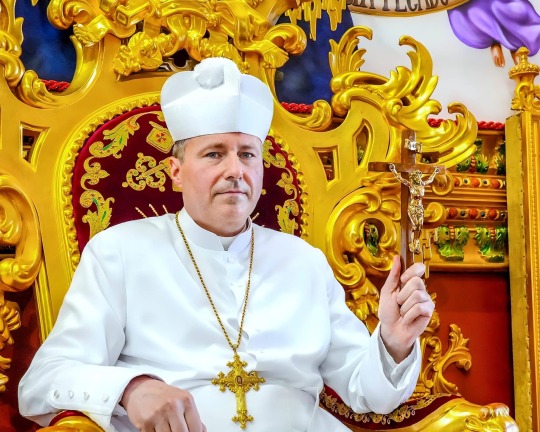
Just be sure to wash your hands after. Look at those creepy Swiss eyes. He's looking at the photographer like he just got caught with a whole bus full of nuns and nothing under his cassock.
Back to America, land of the impressive number of tiny dueling antipopes...

And of course there's the True Catholic Church (yeah, they didn't even try with that one) led by Pope Pius XIII and led from his See in...a chapel in Kalispell, Montana. I'm pretty sure that he was the one and only Pope of the True Catholic Church, but there might be someone in Montana wearing his hat and pimp ring.
I'm not going to get into the SSPX (Society of Saint Pius X) because I want to keep this light (lighter, anyway minus all the cults, rapes, and that sorta thing). Loosely put, they're a bunch of fucking mostly-French nerd-assed schismatics.

Like look at this Tradcath fucker. Just such a fucking loser.
#popes#antipope#catholic#catholicism#cathblr#fancy hats for everyone#palmarians#trad caths#trad catholic#sspx#sedvacantists#wikipedia#chicago pope#leo xiv#pope leo xiv#conclave#american pope#robert prevost#pope bob
36 notes
·
View notes
Text
A great interview with Michael with Collider :), mostly no spoilers (or what already been said elsewhere :)❤)
COLLIDER: Obviously, when you were making the first season of this show, you had the book to work off of, you had a characterization to work off of, but because this season is an all-new thing that Neil Gaiman has written, did you get to work with him at all to develop what Aziraphale was doing this season, or was it all dependent on what he wrote?
MICHAEL SHEEN: Yes, I think when we were doing the first season, Neil always talked about the idea that he and Terry [Pratchett] had talked quite a bit about future storylines and that they had worked out quite a lot of it, actually. They just never got around to writing it down in a book. So there was quite a lot of material already in his head. One of the wonderful things about this, as well, working on this project, has been how much myself and David have been able to collaborate with Neil on the characters and inhabit them and bring them to life, and developing the relationship between them and the storylines. So it’s felt very collaborative, but then, of course, Neil is very good at making it feel collaborative even when he knows exactly what he wants.
QUESTION: Speaking of that relationship between Crowley and Aziraphale, you are obviously quite close with David Tennant. You work with him not only on this but also on Staged. What's it like getting to put that friendship dynamic to use on those shows, especially since Staged is something that's so completely different from Good Omens?
SHEEN: It's just wonderful, really. You know, often you work with actors that perhaps you have very good chemistry with on-screen or on stage, but maybe off-stage, off-screen there's not a particular spark. It's fine, but there's nothing particularly special about your relationship on stage or on-screen. Then other times, there are people you get along with really, really well, but maybe there isn't necessarily that amazing chemistry on-screen or on stage. So it's very rare that you have both. I think with us, we've just sort of discovered that that is the case, or it seems to be that people feel like we have good chemistry together when we're working. And we just have a lovely time together in between working as well, so it's such a pleasure to be able to do that, and to be able to work on projects like Good Omens and Staged with the characters that we play in those. It's just a real joy, so, you know, long may it continue.
QUESTION: Personally, I love the relationship between Aziraphale and Crowley, and the show has had such a massive fan response. How much are you aware of that, and what do you hope fans take away from this season as opposed to the first one?
SHEEN: Oh, I'm very much aware of it. Yeah, it's one of the most enjoyable aspects of working on this, to see how much the audience and in particular Good Omen fans just give to the project. It does feel like a fulfilled kind of creative collaboration with the fans as well. There's so much talent when people come to writing fanfiction or artwork, or just discussing ideas or things that have sort of been born out of it. I mean, there are all kinds of amazing groups who fundraise now for charities and do all kinds of incredible things. There are conventions and all sorts. I love that, and I love seeing how people have made friends, really close friends, through their connection to this and these characters in this story, and how communities have been created, and how much people are helping each other. I see all that online and I hear about it. It feels very in the spirit of the story, you know, it feels very in keeping with what it's all about. I think that's a big part of why Neil and I and the rest of us have all really opened ourselves to that fan community, because I think it feels like a very living part of the story.
QUESTION: How do you think Aziraphale has changed between where we leave him at the end of Season 1 and the beginning of Season 2? Is there anything unusual that we can expect from him this season?
SHEEN: Well, I think he's in a quite odd position for him because, on the one hand, he's got a lot of the things that he's always wanted. He's always wanted to just be left alone and live in his bookshop, and drink tea and listen to music, and read books and go to the theater, and eat nice meals and drink nice wine, and be with the being that he loves being with the most. But on the other hand, he's also someone who feels very anxious about not being part of the company, you know, being out on his own and sort of independent. It’s quite a challenge for him. It’s that thing about “be careful what you wish for.” He got what he wished for, but he still feels a bit off-kilter, I think, and then this unexpected guest arrives and turns the world upside down for him again.
But one of the things that we wanted to explore with Aziraphale in this series is perhaps finding something a little steelier underneath the apparent soft surface, that maybe there's something else going on under there. So we see that kind of come out as the story goes on, as well.
QUESTION: In addition to playing Aziraphale, you also did the voice for Lucifer in The Sandman audio series, which is obviously also a Neil Gaiman joint. So what's the difference between playing an angel and playing a demon?
SHEEN: Well, of course, Lucifer is an angel, was once a fallen angel. My first experience of Neil’s work was The Sandman. That was what I first read when I was still a teenager in the late ‘80s, and it just absolutely blew my mind and opened me up to all kinds of things and started a journey [with] Neil’s work, but also all the people that Neil kind of points you towards through his work as well. It opened so many doors for me. So to be able to then be a part of The Sandman world, as well, to play such an iconic character, it was and is, because we're still doing it, just a bit of a dream come true.
QUESTION: I have one last question for you, and it's a little bit of a silly one. One of the most iconic parts of Good Omens is Crowley's Bentley, which is cursed to play nothing but Queen songs forever and ever. I would love to know what you think Aziraphale’s favorite Queen song is.
SHEEN: Well, I think he likes the more operatic ones. So he probably…I think he likes “Bohemian Rhapsody.” All those nifty chorus bits. He’d love that. So yes, probably “Bohemian Rhapsody.”
#good omens#gos2#season 2#michael sheen#interview#michael interview#fun fact#aziraphale's favourite queen song#queen#bohemian rhapsody#collider#collider 2024#s2 interview
395 notes
·
View notes
Note
Hi!! I hope you're having a good day :-) Do you have any resources on Catholic folk magic? I saw your post about torturing saints until they do what you want and I NEED to know more. Thank you!!!
Hi! Off the top of my head, Sabina Magliocco has done work in this area; her book The Two Madonnas, and quite a few of her articles on Italian folk traditions, address this. If you have JSTOR access, there are two articles in the book Italian Folk (ed Joseph Sciorra), by Magliocco and Sansavato, that will be interesting. Robert Orsi is another expert in folk Catholicism, as is John Ingham. Michael D. Bailey's book Fearful Spirits, Reasoned Follies opens with a discussion of burying a statue of St Joseph to sell your house, and links it to various late medieval practices; also, Peter Brown is the major authority on the medieval European cult of the saints (though IIRC he focuses more on the official manifestations than on folk practices). In a slightly different direction, there's a fair amount of work that's been done on folk saints (Santa Muerte, Maximon, Padre Pio), that could also be of interest.
16 notes
·
View notes
Text
reading a lot about st marys in exile - a catholic church in aus which was quite progressive and social justicey but got their priest removed for not observing liturgy right in a few ways and questioning key doctrines like the divinity of christ etc. so the congregation formed their own splinter chuch that seems to have basically become fancy liturgical Unitarian universalism
but anyway, it's interesting, because obviously the st marys guys want to frame the story as 'we were punished for being progressive' - but the actual problem was largely to do with things like using a different baptismal formula or questioning the divinity of jesus etc. not that the bishop hated them letting homeless people in
at the same time, you might argue that it was harsh of the church hierarchy to make such a big deal when they were doing that kind of good work. does liturgical uniformity matter that much?
but I think there is something to be said for like... adhering to a shared liturgy not because the alternative is sinful, but as a sign of respect for others? doing more or less the same thing as every other catholic church shows you want to be in community with them and values that shared tradition
(also specifically on doing baptism improperly - the uniformity of the baptism rite isn't just about the catholic church insisting you do things this way; it's about having one consistent baptism shared among all historic trinitarian Christians. getting baptised 'right' isn't just because the pope said so, but because it's something that's shared between most denominations. it's a sign of communion in a fragmented body of Christ
and so even if you think it doesn't matter whether you do baptism right, it still seems quite insensitive to me for a priest to do weird and quirky things with baptism because it's like your passport into all of Christianity. it would be really annoying years later to want to become orthodox or anglican or whatever and not having a clear, simple answer on whether you need to be rebaptised because the priest decided to put his own spin on it. it's like if the DMV clerk gave you their own little hand drawn drivers license)
and it's interesting reading the blog posts of Michael carden, a left gay fringe catholic, who is actually quite critical of the st marys in exile hagiography - they'd decided by their actions they didn't want to be catholic, and he suggests the whole thing had become a bit of cult of personality for the main two priests. he's no lover of church authoritarianism nor anti social justice at all; but he bemoans the fact that what could have been a strong progressive voice within the catholic church basically exiled themselves into irrelevance as a fringe community simply because they didn't want to wear vestments
8 notes
·
View notes
Text
RE: Was Baron Samedi worshiped in New Orleans prior to the late 20th century?
This one is also about the actual lwa.
Baron Samedi can aptly be described as not just the most iconic lwa, but one of the most iconic things from New Orleans Voodoo. Ironically, I have only found inconclusive evidence that he was worshiped in New Orleans during the 19th or early 20th centuries.
In American popular media, Baron Samedi is frequently conflated with other Haitian deities, called the Gede. The real-life Baron Samedi has his origins in Haitian Vodou, as does Maman Brigitte (Gran Brijit). The Haitian lwa are derived from African deities, among the most important being the Dahomean trickster god Legba (himself, derived from the Yoruba deity Eshu). Over the course of Haitian history, Dahomean Legba was refracted into Papa Legba, Met Kalfou, and the Gede - by extension, the Bawons, including Baron Samedi. This explains why the Gede are trickster deities of sexuality and liminality, who embrace all that is taboo - just like Dahomean Legba!
19th Century New Orleans Voodoo was greatly influenced by Haitian Vodou, due to the massive influx of Haitian refugees that arrived in the Crescent City after the Haitian Revolution. Following the post-Revolution migration wave, several Haitian lwa became features of New Orleans Voodoo, including:
Papa Legba → “Papa Limba” or “La Bas”, syncretized with St. Peter
Damballah → “Daniel Blanc”, syncretized with St. Michael
Agassu → “Yon Sue”, syncretized with St. Anthony
Ogou Feray could have also been worshiped as “Joe Ferraille” (“Joe Feray”), and Ayizan Velekete as “Vériquité”. While the Erzulies were not directly worshiped per se, veneration of Mother Mary was a key feature of 19th century New Orleans Voodoo. (The Erzulies are syncretized with Mother Mary.)
(I should also note that, in New Orleans, the lwa were called “spirits”, while Bon Dieu/Bondye was simply called “God”)
During the 19th century, the two most important lwa were probably Papa Legba - the Doorkeeper - and Damballah - the most ancient of the lwa. This would explain why their names appear most frequently in 19th- and 20th-century sources, especially in large scale rituals. Damballah might have been refracted into multiple deities, including “Daniel Blanc” and “Zombi the Snake God” – a deity famously associated with Marie Laveau. Others argue that “Grand Zombi” is actually derived from the Kongo supreme deity Nzambi Mpungu, or an invention fabricated by journalists.
A third key deity – “Onzancaire” / “Monsieur Assonquer” – might have been associated with Ogou Feray – one of the most important Haitian lwa. However, the origins of “Onzancaire” are elusive. Because so many different theories have been proposed, I do not know where his true origins lie.
Other deities of non-Haitian origin were also features of New Orleans Voodoo. St. Marron (Jean St. Malo) was the New Orleanian folk saint of runaway slaves. Mother Leafy Anderson – founder of the Spiritual Church Movement in New Orleans – introduced worship of the Native American Saint Black Hawk (see: Kodi A. Roberts (2015) Voodoo and Power: The Politics of Religion in New Orleans, 1881–1940). My understanding is that “Dr. John” (Jean Montaigne) was also deified, in a similar manner to St. Black Hawk. Orisha, such as Shango and Oya, may too have been worshiped. Other deities are listed here and here.
Baron Samedi is conspicuously absent. I think this has to do with the history of Haitian Vodou. Prior to the Haitian Revolution, Haitian Vodou was less of an organized religion, described as a "widely-scattered series of local cults" (see: The Social History of Haitian Vodou, p. 134). It was between the years 1804 and 1860 that Haitian Vodou began to stabilize into a clear predecessor of its present form. (see: The Social History of Haitian Vodou, p. 139) This period of stabilization took place after the migration wave of the early 19th century, which could explain why key features of Haitian Vodou are missing from 19th century New Orleans. For example, I have yet to find evidence that division of the Petwo and Rada lwa made it over to American soil. The refraction of Dahomean Legba might have never been transmitted by Haitian refugees, which would explain the absence of Met Kalfou and the Gede/Bawons from worship.
This too explains why the Papa Legba of American history was both Doorkeeper AND Guardian of the Crossroads. It has been theorized that the legendary “Devil at the Crossroads” was actually Met Kalfou. However, this “Devil” does not match the appearance of Kalfou, described as "no ancient, feeble man...huge and straight and vigorous, a man in the prime of his life." Instead, the one at “the Crossroads” appears as a limping old man who loves music and dogs (“Hellhound on my Trail”). It’s Papa Legba!
Rather than Kalfou, I think American Papa Legba actually inherits his more menacing attributes from Eshu. This would explain why he walks with a limp (like Eshu), is notoriously vengeful (like Eshu), and is sometimes described as androgynous (like Eshu!).
In any case, the Papa Legba of American history can be clearly traced back to Haiti. His appearance as a limping old man is inherited from Haitian Papa Legba; his love of dogs and music from Dahomean Legba. 19th century sources clearly identify him with Saint Peter (“St. Peter, St. Peter, open the door;”) The same cannot be said for Baron Samedi. He was probably not syncretized with St. Expedite, because St. Expedite “did not achieve popularity until the late 1800s or early 1900s in New Orleans” – long after the Haitian migration wave.
I have found one compelling source that places worship of Baron Samedi in 19th century New Orleans. Creole author Denise Alvarado is something of an expert on this topic, her being born and raised in New Orleans. In Witch Queens, Voodoo Spirits, and Hoodoo Saints: A Guide to Magical New Orleans (2022), Denise Alvarado identifies a “Spirit of Death” with Baron Samedi / Papa Gede. The most convincing piece of evidence comes from the second interview, in which the interviewee describes a ceremony where attendees donned purple robes. The color purple has been historically associated with Papa Gede (by extension, Baron Samedi).
That being said, I do think the evidence Alvarado provides is tenuous. Without additional context, it’s difficult to say whether the purple robes are truly linked to the Haitian lwa. The other newspaper article sounds rather sensationalized. The 19th century saw horrendous news coverage of New Orleans Voodoo, where reporters would exaggerate or straight-up fabricate details to demonize Vodouisants. The reporter’s description of the spirits of death does not align with the Haitian Gede or Bawons. It is important to remember that New Orleans Voodoo is not entirely Haitian in origin. Several other traditional African spiritualities are woven into New Orleans Voodoo. Prior to the Haitian migration wave of the early 19th century, one of the main influences was Kongo spirituality, in which ancestor veneration is central. Additionally, the newspaper cited is from the year 1890 – years after Marie Laveau’s death. The reliability of this article is therefore questionable. I think this could be a Damballah / “Grand Zombi” situation, where this “Spirit of Death” bears superficial resemblance to the lwa but isn’t actually him. It is also possible that he is simply a fabrication by journalists.
The defamation of Vodou continued into the early 20th century, as Haiti was occupied by the U.S. between the years 1915 and 1934. I don’t see how worship of the Gede/Bawons could have been transmitted to New Orleans between the end of the Haitian migration wave and year 1934. There’s a good chance that Baron Samedi / Papa Gede only properly became features of New Orleans Vodou during the revitalization movement of the late 20th century.
As such, I propose two hypotheses:
Baron Samedi was not properly worshiped in New Orleans until the late 20th century. He quickly rose in popularity, as he was easily grafted onto the pre-existing worship of the spirits of the dead (ancestors).
Alvarado has correctly identified Baron Samedi / Papa Gede with the “Spirit of Death”; however, this “Spirit of Death” was a radical departure from his Haitian predecessor, taking on a markedly different form from the lwa.
But that’s all just a Theory… A GAME THEORY!!!
…Anyways, annotated bib:
Marshall, Emily Zobel. American Trickster: Trauma, Tradition and Brer Rabbit. Rowman & Littlefield, 2019.
Chapter 1 ("African Trickster in the Americas") describes Dahomean Legba’s origins in the Yoruba deity Eshu.
Cosentino, Donald. "Who is that fellow in the many-colored cap? Transformations of Eshu in old and new world mythologies." Journal of American Folklore (1987): 261-275. https://www.jstor.org/stable/540323.
From the abstract: “Myths of Eshu Elegba, the trickster deity of the Yoruba of Nigeria, have been borrowed by the Fon of Dahomey and later transported to Haiti, where they were personified by the Vodoun in the loa Papa Legba. In turn, this loa was refracted into the corollary figures of Carrefour and Ghede.” Accessed here: https://www.centroafrobogota.com/attachments/article/24/17106647-Ellegua-Eshu-New-World-Old-World.pdf
Haitian immigration : Eighteenth and Nineteenth Centuries. The African American Migration Experience. https://www.inmotionaame.org/print.cfm@migration=5.htm
Describes post-Haitian Revolution migration wave like so: “the number of immigrants [from Haiti to New Orleans] skyrocketed between May 1809 and June 1810… The 1809 migration brought 2,731 whites, 3,102 free persons of African descent, and 3,226 enslaved refugees to the city, doubling its population.”
Fandrich, Ina J. “Yorùbá Influences on Haitian Vodou and New Orleans Voodoo.” Journal of Black Studies, vol. 37, no. 5, 2007, pp. 775–91. JSTOR, http://www.jstor.org/stable/40034365. Accessed 23 June 2024.
Mentions worship of Ogou Feray as “Joe Ferraille”. Fandirch herself cites Long, C. M. (2001). Spiritual merchants. Knoxville: University of Tennessee Press, p. 56: https://archive.org/details/spiritualmerchan0000long/page/56/mode/2up?
Long, Carolyn Morrow. A New Orleans voudou priestess: The legend and reality of Marie Laveau. University Press of Florida, 2007, p. 247: https://books.google.com/books?id=_XzSEAAAQBAJ&pg=PT247#v=onepage&q&f=false
Mentions worship of Ayizan Velekete as (the male) “Vériquité”.
Anderson, Jeffrey E. Hoodoo, voodoo, and conjure: A handbook. Bloomsbury Publishing USA, 2008, p. 15: https://books.google.com/books?id=TH7DEAAAQBAJ&pg=PA15&lpg=PA15#v=onepage&q&f=false
Relevant quote: "Blanc Dani, Papa Lébat, and Assonquer make the most frequent appearances in both nineteenth- and twentieth-century sources. The first two, in particular, figure prominently in large-scale rituals."
Humpálová, Denisa. "Voodoo in Louisiana." (2012). https://dspace5.zcu.cz/bitstream/11025/5338/1/BP%20Denisa%20Humpalova%202012.pdf
One of several sources that identifies “Grand Zombi” with Nzambi Mpungu.
Long, Carolyn Morrow. A New Orleans voudou priestess: The legend and reality of Marie Laveau. University Press of Florida, 2007, p. 247: https://books.google.com/books?id=_XzSEAAAQBAJ&pg=PT247#v=onepage&q&f=false
Posits that “Grand Zombi” could be derived from Nzambi Mpungu, or "may be the invention of journalists inspired by "zombie tales" of Haiti's infamous living dead, combined with Moreau de Saint-Méry’s endlessly repeated description of a snake-worshiping ceremony in colonial Saint Domingue."
Anderson, Jeffrey E. Voodoo: An African American Religion. LSU Press, 2024, p. 46: https://www.google.com/books/edition/Voodoo/O-v3EAAAQBAJ?hl=en&gbpv=1&dq=%22assonquer%22+%22azewe%22+vodou&pg=PA46&printsec=frontcover
Describes several possible origins for the elusive “Onzancaire”, including a theory that he was a deity related to Ogou Feray.
Long, Carolyn Morrow. A New Orleans voudou priestess: The legend and reality of Marie Laveau. University Press of Florida, 2007, p. 236: https://books.google.com/books?id=_XzSEAAAQBAJ&pg=PT236#v=onepage&q&f=false
One of several sources to describe St. Marron (Jean St. Malo).
Roberts, Kodi A. Voodoo and Power: The Politics of Religion in New Orleans, 1881-1940. LSU Press, 2015, p. 82: https://books.google.com/books?id=EWOkCgAAQBAJ&pg=PT82&lpg=PT82
Describes how Mother Leafy Anderson (founder of the Spiritual Church Movement) “found” St. Black Hawk, introducing him to New Orleans Voodoo.
Alvarado, Denise. Witch Queens, Voodoo Spirits, and Hoodoo Saints: A Guide to Magical New Orleans. Weiser Books, 2022, p. 39: https://books.google.com/books?id=ktlWEAAAQBAJ&pg=PA39&lpg=PA39#v=onepage&q&f=false
Posits that high priestess Betsy Toledano worshiped the Orisha Shango and Oya during the 19th century.
Anderson, Jeffrey E. Hoodoo, voodoo, and conjure: A handbook. Bloomsbury Publishing USA, 2008, p. 15: https://books.google.com/books?id=TH7DEAAAQBAJ&pg=PA15&lpg=PA15#v=onepage&q&f=false
List of deities worshiped in 19th century New Orleans Voodoo.
Alvarado, Denise. Witch Queens, Voodoo Spirits, and Hoodoo Saints: A Guide to Magical New Orleans. Weiser Books, 2022, p. 126: https://www.google.com/books/edition/Witch_Queens_Voodoo_Spirits_and_Hoodoo_S/ktlWEAAAQBAJ?hl=en&gbpv=1&pg=PA126
Another list of deities worshiped in 19th century New Orleans Voodoo.
Mintz, Sidney & Trouillot, Michel-Rolph (1995) “The social history of Haitian Vodou” in Cosentino, Donald J., ed., Sacred Arts of Vodou, Chapter 4. LA: UCLA Fowler Museum, 123-47. P. 134: https://ghettobiennale.org/files/Trouillot_Mintz_LOW.pdf
Describes Haitian Vodou as a "widely-scattered series of local cults" prior to the Haitian Revolution.
Mintz, Sidney & Trouillot, Michel-Rolph (1995) “The social history of Haitian Vodou” in Cosentino, Donald J., ed., Sacred Arts of Vodou, Chapter 4. LA: UCLA Fowler Museum, 123-47. P. 139: https://ghettobiennale.org/files/Trouillot_Mintz_LOW.pdf
Describes the stabilization of Haitian Vodou into a predecessor of its current form. This occurred between the years following the Haitian Revolution and year 1860.
Deren, Maya. Divine Horsemen : The Living Gods of Haiti. New Paltz, NY: McPherson, 1983 (originally published in 1953), p. 101: https://archive.org/details/divinehorsemenli00dere/page/100/mode/2up
Description of Kalfou (Carrefour) as "no ancient, feeble man...huge and straight and vigorous, a man in the prime of his life." Deren conducted her ethnographic work during the 1940s and 1950s.
Marvin, Thomas F. “Children of Legba: Musicians at the Crossroads in Ralph Ellison’s Invisible Man.” American Literature, vol. 68, no. 3, 1996, pp. 587–608. JSTOR, https://doi.org/10.2307/2928245. Accessed 23 June 2024.
Description of “The Devil at the Crossroads” as a musical genius and “limping old black man”: “Most versions of this story instruct the aspiring musician to bring his instrument to a lonely crossroads at midnight and await the arrival of a limping old black man who will tune the instrument, play it briefly, and then return it endowed with supernatural power."
Robert Johnson’s song “Hellhound on My Trail” identifies “The Devil at the Crossroads” with Papa Legba, who is associated with dogs.
Long, Carolyn Morrow. A New Orleans voudou priestess: The legend and reality of Marie Laveau. University Press of Florida, 2007, p. 244: https://books.google.com/books?id=_XzSEAAAQBAJ&pg=PT244&lpg=PT244#v=onepage&q&f=false
Relevant quote: "Mary Washington, born in 1863, said she was trained in the arts of Voudou by Marie Laveau. She remembered a song that was sung at the weekly ceremonies: "St. Peter, St. Peter open the door; I am callin' you, come to me; St. Peter, St. Peter open the door." Mrs. Washington explained that "St. Peter was called La Bas, St. Michael was Daniel Blanc, and Yon Sue was St. Anthony." She also mentioned a spirit called Onzancaire."
Alvarado, Denise. The Magic of Marie Laveau: Embracing the Spiritual Legacy of the Voodoo Queen of New Orleans. Weiser Books, 2020, p. 57: https://books.google.com/books?id=SZOMDwAAQBAJ&pg=PA57&lpg=PA57#v=onepage&q&f=false
Relevant quote: “Baron Samedi remains a popular and powerful force in New Orleans Voudou today, along with his wife Manman Brigit. He is syncretized with St. Expedite, among the most popular of saints in New Orleans. We do not hear of St. Expedite in association with Marie Laveau, however, because he did not achieve popularity until the late 1800s or early 1900s in New Orleans (Alvarado 2014).”
Alvarado, Denise. Witch Queens, Voodoo Spirits, and Hoodoo Saints: A Guide to Magical New Orleans. Weiser Books, 2022, pp. 127-128: https://books.google.com/books?id=GsofEAAAQBAJ&pg=PA127&lpg=PA127#v=onepage&q&f=false
This is the strongest evidence I could find that Baron Samedi / Papa Gede was worshiped in 19th - early 20th Century New Orleans.
Deren, Maya. Divine Horsemen : The Living Gods of Haiti. New Paltz, NY: McPherson, 1983 (originally published in 1953), p. 107: https://archive.org/details/dli.ernet.505921/page/107/mode/2up?q=purple
Historical evidence that, since at least the 1940s, Papa Gede’s colors are “black or purple”. To this day, purple is associated with Baron Samedi and the Gede as a whole.
Long, Carolyn Morrow. A New Orleans voudou priestess: The legend and reality of Marie Laveau. University Press of Florida, 2007, p. 250: https://books.google.com/books?id=_XzSEAAAQBAJ&pg=PT250&lpg=PT250
Relevant quote: “The religion that evolved in nineteenth-century New Orleans and was embraced by Marie Laveau and her Voudou society combined traditions introduced by the first Senegambian, Fon, Yoruba, and Kongo slaves with Haitian Vodou, European magic, and folk Catholicism. It also absorbed the beliefs of blacks imported from Maryland, Virginia, and the Carolinas during the slave trade of the 1830s–1850s. These “American Negroes” were English-speaking, at least nominally Protestant, and practiced a heavily Kongo-influenced kind of hoodoo, conjure, or rootwork. New Orleans Voudou is therefore not identical to Haitian Vodou, but represents a unique North American blend of African and European religious and magical Traditions.”
Fandrich, Ina J. “Yorùbá Influences on Haitian Vodou and New Orleans Voodoo.” Journal of Black Studies, vol. 37, no. 5, 2007, pp. 775–91. JSTOR, http://www.jstor.org/stable/40034365. Accessed 23 June 2024.
Describes major Senegambian and Kongo influences on New Orleans Voodoo, prior to the Haitian Revolution. Relevant quote: “New Orleans's African population was Kongo dominated with a strong affinity with the spirits of the dead…Dahomeyan influence occurred only indirectly through the Haitian refugees who "flooded" the city after 1808. In 1809 alone, more than 10,000 Haitians arrived, and doubled the city's population. They brought their Vodou religion with them, which ultimately merged with the already existing New Orleans or Louisiana Voodoo traditions. During the French colonial regime, 80% of the enslaved Africans came from one single ethnic group: the Bamana (also called Bambara) people from the Senegal River basin (today's Senegal, Gambia, and Mali), most of them stemming from one single ethnic group, the Bambara people. The majority of the remaining 20% were Kongolese and some Dahomeyans (Hall, 1992). Despite their rather different geographical origins, these two cultures blend easily into one another. Eighteenth-century Louisiana Voodoo maintained a marked Senegambian flavor, with some Kongolese elements blended in, until the end of the 18th century.”
Dubois, Laurent. “Vodou and History.” Comparative Studies in Society and History, vol. 43, no. 1, 2001, pp. 92–100. JSTOR, http://www.jstor.org/stable/2696623. Accessed 23 June 2024.
An overview of the history of Haitian Vodou, as it pertains to U.S. history. Demonization of Vodou continued past the U.S. occupation of Haiti, until the late 20th century.
#between the two it is 100% papa legba who had a bigger impact on horror stories from the american south of the early 20th century#i think a lot of people would think it's baron samedi but no! it's the mischevious limping old man!#commentary#the loa (hazbin hotel)#baron samedi (hazbin hotel)#big papa legba
12 notes
·
View notes
Text
has anybody watched a movie called The Devil Conspiracy about this cult stealing DNA from corpses of important historical figures and injecting them into fertilised eggs to impregnate women and make them give birth to essentially babies with the same genius/talent as those historical figures?
like and there's this cute priest who gets stabbed to death trying to stop this evil lady from stealing the shroud of Turin to ressurect baby jesus and free the devil. and then st Michael shows up to earth and posses the priests body and tries to stop them and and and
HUH??????
#the devil conspiracy#the craziest most bonkers and funniest movie ever#PLEASE GO WATCH IT PLEASE#IT'S ONE OF MY FAVE BECAUSE IT'S SO CRWZY LMAOKL#I AM BEGGING#good omens#good omens crowley#crowley#aziraphale x crowley#aziraphale#bible#jesus#christian movies#supernatural#spn#Castiel#Dean winchester#sam winchester#john constantine#constantine 2005#angels#demons#Angel#demon
35 notes
·
View notes
Text
There Is No Safe Word (Part 10 of 10)
(Source) (Part 1) (Part 2) (Part 3) (Part 4) (Part 5) (Part 6) (Part 7) (Part 8) (Part 9) (Prewarning)

May 16, 2022: From a video message to Pavlovich. Photo: Courtesy of Scarlett Pavlovich.

January 20, 2023: A text to Pavlovich after she filed a police report. Photo: Courtesy of Scarlett Pavlovich.
Editor’s note: This story contains content that readers may find disturbing, including graphic allegations of sexual assault & child abuse.
This past fall, Pavlovich began studying for a degree in English literature at the University of St. Andrews in Scotland. As it happens, the university had awarded Gaiman an honorary degree in 2016. In December, Pavlovich approached the head of the university, Dame Sally Mapstone, to share her experience and ask the university to review the decision to honor Gaiman. Mapstone was sympathetic but indecisive; some on the board, she told Pavlovich, would likely want evidence of prosecution to rescind his degree. As far as the police report goes, the “matter has been closed,” a spokesperson says. Gaiman’s career, meanwhile, has been marginally affected. A few pending adaptations of his novels and comics have been put on hold or canceled. But the second season of The Sandman is set to premiere on Netflix this year, as is Anansi Boys on Amazon Prime. (Amazon did not return a request for comment.) He and Palmer are entering the fifth year of an ugly divorce and custody battle. Gaiman has “bled her dry” in the divorce proceedings, according to someone close to her. She’s moved back in with her parents in Massachusetts. (Gaiman’s representatives alleged that Palmer was a “major force” driving this story in light of their contentious divorce.)

Michael Stipe, former R.E.M. singer who is also a friend of Caroline Wallner, hosted Pavlovich, Stout, & Wallner at his house on Dec 31, 2024.
In December, Pavlovich flew to Atlanta to meet some of the other women who had made accusations against Gaiman. They had been unaware of one another’s existence until they’d heard the podcast. Since then, they had formed a WhatsApp group and grown close. “It’s been like meeting survivors of the same cult,” Stout tells me. “It’s impossible to understand unless you were there.” On New Year’s Eve, Pavlovich, Stout, and Wallner gathered around a bonfire at the Athens home of the musician Michael Stipe, an old friend of Wallner’s. Kendall joined them on FaceTime. With their dark hair and delicate features, they looked like they could be sisters. Around 11 p.m., they wrote down their intentions for the year and cast the scraps of paper into the fire. Pavlovich had written that she wanted to ���release the yoke of victimhood” and “invite in self-acceptance.” The next morning, she woke before the others, made coffee, cleaned the kitchen, and sat on the porch in the winter sun. “Am I happy?” she wrote in her journal. “No.” But she also noted that she wasn’t alone. “There is no need to feel abandoned anymore.”
Back to: Part 9
#tw: sa#tw sa mention#neil gaiman#neil gaiman allegations#good omens#good omens fandom#neil gaiman accusations#neil gaiman abuse#tw child abuse#tw childhood trauma#the sandman#lila saphiro
3 notes
·
View notes
Text
Make Your Passion Project Now With Filmmaker Michael Patrick Jann.
Writer/Director/Producer Micheal Patrick Jann ("Drop Dead Gorgeous", "The State", "The Good Doctor") and I are holding a live webinar called "Make Your Passion Project Now" on Feb. 18th. 6pm Pacific. Live with a spirited Q&A and VIP pop ins. Sign up here.
100% of the ticket sales go to Red Cross LA to help the victims of the LA fires. Graciously hosted by our dear friends at the Filmmakers Academy.
Born of a chat Michael and I were having, he said, "while it's good to know the difference between 24mm and 70mm lenses and have a rich friend who is also a movie star, it doesn't matter if you can't define and explore your vision." Your vision is the center of everything, and without it, you have no project. What is your vision, and how does that vision make the journey from your heart to the screen? What are you trying to say? How do you communicate that?
This class is about figuring out how master filmmakers have answered these questions and put their vision on the screen... and, most importantly, how you can do this as well. We will discuss and study several great films and filmmakers - with a particular emphasis on distilling the filmmaker's vision and intent and how they brought that to life. See you all there.
COMMERCIAL DIRECTING BOOTCAMP 04.05.2025 We're donating 50% of your Bootcamp tuition to charities and GoFundMe's to help the fire victims. Filmmakers learn how to win jobs and craft better work that leads to more opportunities. Agency creatives will learn how the flow goes on-set before the shoot. Limit 10 filmmakers. Includes one-on-one onboarding call. Enroll now to direct with confidence.
FILMMAKER RETREAT JOSHUA TREE '25 Thursday, September 25th – Sunday, September 28th, 2025. Limit 15 Filmmakers. This will be our 4th year and it's so special, I'd prefer to jump on the phone with you and tell you more. Every year since our first, filmmakers have come back. Pretty much says it all. SIGN UP!
ONLINE FILMMAKING COURSES - DIRECT WITH CONFIDENCE Each of my online courses come with a free 1:1 mentorship call with yours truly. Taking the Shadow course is the only way to win a chance to shadow me on a real shoot! DM for details. Want to level up your commercial directing game?
MAGIC MIND - MY MENTAL PERFORMANCE EXILIR - JAN SPECIAL 45% Save hugely on Magic Mind by using this special 45% off the Magic Mind Bundle in January with coupon link for MAGIC MIND — This link is the way.
Thanks,
Jordan
My cult classic mockumentary, “Dill Scallion” is online so I’m giving 100% of the money to St. Jude Children’s Hospital. I’ve decided to donate the LIFETIME earnings every December, so the donation will grow and grow annually. Thank you.
“Respect The Process” podcast is brought to you by Commercial Directing FIlm School and True Gent, aka True Gentleman Industries, Inc. in partnership with Brady Oil Entertainment, Inc.
Check out this episode!
0 notes
Text
I'm very much in agreement with her suggestions here. Yes, this is a shrine for the cult of Sts Crowley and Aziraphale, so let's treat it with the reverence it deserves. Don't deface it to the point where park maintenance is forced to remove it. Be mindful that there are also non-fandom visitors to the park. In short, be good citizens - those are in short supply in some quarters these days, we need all the good examples we can get.
(PS - I like to think the *original* bench has been smuggled off to Scotland or somewhere, to participate in the filming. Or maybe it lives in Michael or David's back garden).
The GO bench in St James Park has been replaced with a different one
Very sorry to report that the sanded down bench they returned at the original spot in St James Park is actually NOT the OG fandom one.
There are some very prominent features the OG bench had. Most importantly, the shape of the back of the bench, the armrest shape, and the height of the bench itself:
OG bench (pic taken last year):

The new bench, unfortunately, has a different back shape (the tops of the left and right wooden planks at the back):


I did some ineffable detective work in St James Park this weekend of 25th January (with the help of @0xlilith and @fuckyeahgoodomens and @fuzzywhispersbear) and examined all the benches in the near vicinity and subsequently all the benches in the park, in case they just moved it to a different spot. They did not.
I now have a special photo folder in my phone featuring some of the possible candidate benches in St James Park, because that's what you do if you are a GO fan on a trip to London.

All the potential candidate benches that fit the shape criteria didn't meet the "recently cleaned" criterion or the "at least a bit visible carving scars in the right places" criterion.

(A very useful graphics made by @fuckyeahgoodomens)
It is, of course, possible that I am wrong and the bench is there somewhere and has been cleaned so well that not even the carving scars are visible. I just recorded all the Clues as I collected them and this is the logical conclusion:
I think it is realistic to consider that the OG bench was damaged beyond salvation and as such, was removed permanently. I feel like maybe some of the carvings were too deep and beyond repair. I might be wrong, they just might be rotating the benches and our bench is just sitting somewhere in storage, waiting for being cleaned and returned. (It is probably not in different park because all benches have a SJP at the back and I think they make sure to not mix them up).
I, personally, am actually fine with fans writing on the bench. It is within my personal limits of what is OK. But some of the fandom love was maybe too vigorous. And as a whole, I think that this shows us that we might try to treat the new bench with a bit more respect. By refraining from carving in it with a knife. By using plain pencils to write our little notes so that they don't destroy the bench, are easily cleaned and are not visible to regular visitors of the park, only for people who know what they are looking for. Use it as a scavenger hunt place (my personal favourite) to leave little trinkets and gifts for other fans (but hide them well so that they don't visually disturb regular visitors).
I am not openly promoting vandalism here. I am just being realistic and I seriously have nothing but love for the people who left their permanent mark on the bench. (And I would HATE for this post to be used for hating on these fans. Pls don't.) I believe we can find a sweet spot of showing our love for the bois and not damaging the bench beyond salvation.
And I think the management of St James Park is showing us that they are just doing their job and they don't hate us (hopefully).
Why? Because the heart padlock of Aziraphale and Crowley is still there. Someone even added another padlock and a little fly! And these things didn't disappear. I think this hopefully demonstrates that fandom activities in moderation are allowed.

The bench is a symbol of fandom love and as such, I don't think it can be lost. It is what we make it. There is a new lovely bench at the spot and it attracts GO fans just like the previous one did. And while I know many people (including me) will grieve the piece of fandom history that might have been lost, I think that this is an opportunity for a fresh start.
We'll be OK. This place still feels loved.
394 notes
·
View notes
Text
Cult Faction Podcast Ep. 128: The Greasy Strangler
In this week’s episode we shine our spotlight on The Greasy Strangler, a 2016 American black comedy horror film directed by Jim Hosking, and written by Hosking and Toby Harvard. The film stars Michael St. Michaels, Sky Elobar, Elizabeth De Razzo, Gil Gex, Abdoulaye NGom and Holland MacFallister. https://cultfaction.com/wp-content/uploads/2024/10/Episode-128.mp3
#Abdoulaye NGom#Black Comedy#bullshit artist#Eastbound and Down#Elizabeth De Razzo#Gil Gex#Holland MacFallister#hootie tootie disco cutie#Horror#Jim Hosking#John Travolta#Michael St. Michaels#Psycho Ape!#Sky Elobar#The Greasy Strangler#The Once and Future Smash#Toby Harvard
0 notes
Text

SAINTS SEPTEMBER 29 "There is only one tragedy in this life, not to have been a saint."- Leon Bloy
St. Theodota, Roman Catholic Martyr and penitent, she was converted and refused to obey the decree of the local prefect for all citizens of Philipopolis, Thrace (modern southeast Balkans), to participate in the festival of Apollo. Hundreds of Christians followed her lead, and she was arrested and put to torture, she was finally stoned to death. Feastday Sept 29
September 29th: St Rene Goupil, SJ
St. Rhipsime, Roman Catholic Virgin martyr who was put to death with a group of fellow virgins in Armenia. Brought before King Tiridates. Rhipsime refused the royal favors and was put to death by being roasted alive. Gaiana and all of the other maidens except one, called Christiana, were massacred by Armenian soldiers. Christiana later became a missionary in Georgia. Feastday Sept 29
Bl. Miguel de Aozaraza Roman Catholic Dominican priest. and a Martyr of Japan. Feastday Sept 29
Bl. Richard Rolle de Hampole, 1349 A.D. English mystic and hermit. Born at Thornton, Yorkshire, England, circa 1300, he was educated at Oxford and in Paris from 1320-1326, before entering into the life of a hermit on the estate of a friend, John Dalton of Pickering in 1326. After several years of intense contemplation, he took to wandering across England, finally settling down at Hampole where he assisted the spiritual development of the nuns in a nearby Cistercian community. He died there on September 29. Richard was very well known and his writings widely read during the fourteenth and fifteenth centuries. He was one of the first religious writers to use the vernacular. A cult developed to promote his cause after miracles were reported at his tomb, although the cause was never officially pursued. His works include letters, scriptural commentaries, and treatises on spiritual perfection. Perhaps his best known writing was De Incendio Amoris. He also wrote a poem, Pricke of Conscience.
ST. MICHAEL, ARCHANGEL-St Michael the Archangel is the Prince of the heavenly hosts, always at the head of the angelic legions as they continually battle against the forces of evil. Devotion to St Michael, whose feast is celebrated on September 29th, has universal reach.
ST. RAPHAEL, ARCHANGEL-The cult of archangel Raphael can be traced back to the 11th century; his feast day is celebrated together with that of the archangels Michael and Gabriel. His name comes from the Hebrew “Rafa-El,” or “medicine of El [God],” the opposite of the name of the demon Asmodeus, “he who causes to perish.”
B. NICOLA OF FORCA PALENA, JEROLAMIN
ST. GABRIEL, ARCHANGEL
1 note
·
View note